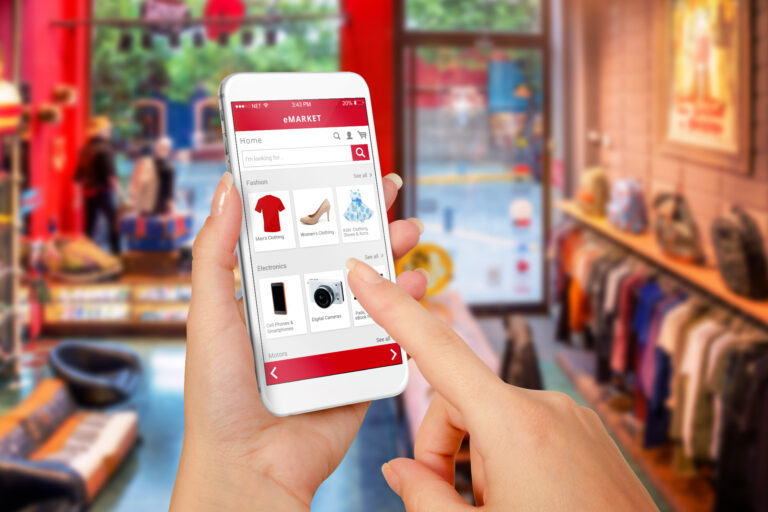In Plain Language About E-commerce Terms
The development of e-commerce is happening at such a pace that we could not have imagined a few years ago. Modern brands use various digital technologies and tools to increase the efficiency of e-commerce and reach a wide audience. Today, we have prepared a glossary of e-commerce terms that will help you speak the same language as e-commerce specialists and understand the current agenda.
D2C (direct-to-consumer) is a sales method where a brand or manufacturer sells products or services directly to the consumer without intermediaries. Usually, intermediaries between the manufacturer and the buyer are multi-brand retail or online stores or distributors. But the manufacturer or brand can contact the consumer directly – through online platforms (marketplaces), websites, or mobile apps. This sales method allows the brand to have more control over its e-commerce marketing and financial metrics, to achieve a better user experience for consumers, and to receive more immediate and detailed feedback.
Omnichannel commerce is an approach to commerce that involves the simultaneous and integrated use of multiple online and offline channels, various ways of interaction between the customer and the company. For example, this may be an online store or website, a mobile app, and a storefront on a marketplace in combination with physical sales points, a service center, and business accounts on social networks. Unlike simple multichannel, omnichannel is customer-oriented and assumes a seamless transition from one channel to another. No matter what channel a potential or existing customer turns to, communication will continue from the place where it stopped last time. In addition to greater customer satisfaction, this strategy allows for mapping interactions with each of them. Read more about the differences between omnichannel and multichannel commerce here.
Customer Experience (CX) is the overall impression a customer gets during their interactions with a brand before, during, and after purchase. From marketing to sales, product selection to customer service, the customer experience is influenced by many factors, including the appearance of a store, product selection ease, the behavior of sales associates and chatbots, payment and delivery speed, product quality and usability, clear and simple instructions, and more. A good CX helps to not only improve marketing metrics in the moment (such as conversion rates and website revenue for an e-commerce store), but also to build and maintain customer loyalty and brand reputation, and ultimately increase market share.
The MDM (master data management) platform is a comprehensive software solution for managing the most important business data, such as information about customers, products, services, sales channels, business processes, partners, etc. It provides accuracy, completeness, and timeliness of information at any time and for any user. Without using such a tool, it is almost impossible to implement an omnichannel strategy in e-commerce. An example of an MDM platform is Syntes MDM, developed using innovative big data technologies. It stores all business data, synchronizes information from all sales channels, and integrates all external and internal sources of information creation and receipt.
A PIM system (product information management system) is software that specializes in managing all product content within an organization across all stages of the product lifecycle and all sales, marketing, and support channels. This tool provides uniformity and brand compliance for product information, reduces the company’s operational costs, and improves the user experience. You can read more about PIM systems here. A PIM system can be implemented as a standalone application or be part of an MDM platform, and we have also dedicated a separate article to this question.
DAM (Digital Asset Management) is a tool designed to manage, store, and widely distribute digital assets, including categories of materials such as photos, documents, music, videos, graphics, and other materials. It allows you to maintain brand standards and high efficiency. During marketing and advertising campaigns, multimedia and rich content are quickly and easily transferred between employees and external users while preserving access restrictions.
Websites and SEO
SEO (search engine optimization) – there are many different factors that can impact a website’s ranking and its place in search engine results – such as Google or Yandex. Among these factors are the presence of keywords, the quality and relevance of content, URL structure, and the number of links to our site from other sites. By changing these and other elements of the site, you can improve its ranking and increase the amount of traffic it receives from search engines. This process is called SEO.
UI design is the design of the user interface. The user interface is the part of your website and application that visitors interact with directly: visual elements, buttons, forms, etc. The goal of UI design is an aesthetically pleasing, attractive appearance. However, the user also expects the site to be user-friendly. That’s where UX design comes in – the design of the user experience. UX design is focused on guiding the user through the path intended by developers and marketers in the most user-friendly way possible and anticipating different ways of interacting with the application. This task is also solved with visual means, so it’s difficult to separate UI and UX design. Most often it’s referred to as UI/UX design.
CPC (cost per click) – it’s a metric that shows how much an advertiser pays for each user’s transition to an advertisement (announcement, banner, etc.). It’s also a relatively common payment model for advertising campaigns. If CPC serves as a payment model, it depends on the popularity of the advertising platform and the theme of the advertisement (that is, how many competitors want to place their advertisement there). If the advertisement is paid according to a different principle (for example, per thousand impressions, CPM), then the cost per click becomes an indicator. It depends on how relevant the advertisement is to the audience, how noticeable and attractive the design is. In this case, marketers strive to reduce CPC, to make each user’s click cost the company less.
CPA (cost per action) – this is one of the main metrics of the advertising campaign, showing how much the target user action costs. For example, filling out a form, ordering a product, installing an application, etc. It depends on the cost of advertising, the conversion of the advertisement and the website. CPA can also be used as a payment model in advertising networks, but significantly less often than CPC.
Lifetime value (LTV) of a customer is the profit that a company will receive from a customer for the entire time of interaction with them. It is determined based on data on how long the average customer remains a customer, on what amounts of purchases and profits can be expected. The company can influence this indicator by improving the user experience, reducing customer churn or reactivating former customers, increasing the average check or frequency of purchases through advertising campaigns, promotions, and loyalty programs. LTV provides an understanding of what CPA is still profitable for the company and what is no longer.
Current Technologies
In this part of the glossary, we will touch on modern technologies that are currently defining the trends in e-commerce development.
AI (artificial Intelligence) is a type of computer program that can learn from experience and draw conclusions from data it receives. Predefined algorithms change and adapt during the learning process to simulate the unique flexible thinking of the human brain. Artificial intelligence can be used to support users, optimize sales, targeted marketing, improve lead generation, and more. Read a detailed article on the uses of AI in e-commerce here.
ML (machine learning) is an extension of artificial intelligence technology that uses mathematical data models to allow the program to learn from experience without direct instructions from its creators. Machine learning algorithms identify patterns in data, which allows them to make predictions about future results. This principle is used in dynamic pricing for airline ticket sales, news feeds on VKontakte, and offering additional products to marketplace customers.
Big data refers to large volumes of data generated on the internet by businesses, social networks, and users. The unique feature of big data is that it can be used for advanced analytics, forecasting, and identifying patterns and correlations that would otherwise remain hidden. For example, big data can help understand and predict customer behavior, optimize pricing and logistics, and more. Big data requires specific methods for storage, processing, and analysis, as well as the application of artificial intelligence technologies.
Headless commerce is an approach to e-commerce that involves separating data and internal processes from the user interface. Information about products, prices, inventory, orders, etc., is stored on the server and can be transmitted to various interfaces, such as a mobile app or an online store on a website. This approach enables the launch of new sales channels and the implementation of technological and marketing innovations without having to overhaul the entire system. The advantages of headless commerce were discussed in one of our articles.
API (application programming interface) is a standardized protocol for data transfer that enables the integration of different software programs. The use of APIs allows large developers to attract and integrate their software with existing ones on the market. Users can create their own applications based on data obtained through this protocol. For example, through APIs, sellers can retrieve data from marketplaces in a convenient format or upload new products.
SaaS (software as a service) is a cloud-based software model where users access tools and data through a developer-provided interface, rather than purchasing individual software versions. They pay for this access through a subscription model, without capital costs for licensing. Benefits of this model include reduced costs, accessibility from multiple devices and interfaces, centralized data storage, flexible and up-to-date functions, predictable and consistent costs, quick implementation, and the ability to integrate with business systems.
Marketplaces
In recent years, we have all witnessed the explosive growth of marketplaces, and now they occupy dominant positions in the consumer market. This part of the glossary is about terms from this area.
Marketplace – an online platform that connects buyers and sellers. Sellers have the opportunity to reach a multi-million audience, and buyers have a huge database of products, comfortable conditions for searching, ordering, and delivery. Among marketplaces, there are platforms with the widest range of goods, such as Ozon, Wildberries, and Amazon, as well as specialized B2B platforms (Alibaba), industry-specific solutions (Etsy for handmade goods, iHerb for dietary supplements), etc.
Fulfillment – the execution of an order. This includes picking, packing, storage, delivery, and order tracking. There are two main formats of fulfillment: FBS and FBO.
FBS (fulfillment by seller) – delivery from the seller’s warehouse. The seller stores the goods in their own warehouse and, when a new order is received, picks, packs, and labels it before delivering it to the marketplace warehouse for further shipment to the buyer. Amazon calls this model FBM (fulfillment by merchant). There is also a format called Real FBS, where the marketplace is not involved in the delivery process at all and the seller delivers the goods directly to the customer.
FBO (fulfillment by operator) – delivery from the marketplace warehouse. The seller sends the goods in batches to the marketplace warehouse before they are put up for sale. Picking, packing, and shipping of orders are done on the marketplace side. Trading platforms have different names for this model, which can be confusing – for example, FBA (fulfillment by Amazon), FBY (fulfillment by Yandex), etc.
PUP (pick-up point) – a marketplace order pickup point. Here, buyers can pick up or return goods, and many PUPs also allow for fitting before purchase. Some PUPs can be automated, in the form of postamats. Pickup points are opened either by the marketplace itself or by small franchisees, with certain requirements for their operation. Large marketplaces open pickup points based on partnership networks (for example, Amazon opens its points in large department store chains).
SKU (stock keeping unit) – a product identification code that enables it to be recognized using scanners and software tools. However, this term is often used in conversation to refer to a separate nomenclature position (with its own code) in the seller or marketplace assortment. Products of different colors, sizes, and even storage periods are different SKUs.
Brand storefront – a personalized brand page on a marketplace. Such storefronts may contain not only information about products, ratings, and reviews but also a narrative about the brand’s concept and history, rich content such as widgets, banners, slides, and more.
Syntes, an international company, develops a next-generation MDM (Master Data Management) and PIM (Product Information Management) cloud platform and provides brands and manufacturers with services for creating, managing and automating D2C (Direct-to-Customer) sales and marketing channels. Syntes solutions and services are used by the world’s leading brands and manufacturers of consumer and business products such as Razer, Scarlett, Pantone, X-Rite, AVerMedia and others. Syntes is a registered trademark of Syntes, Inc.
Mentioned trademarks and company names are registered trademarks of their respective owners.
© Copyright Syntes, Inc. Copying, reprinting, and any reproduction is permitted only with the written permission from Syntes, Inc.






